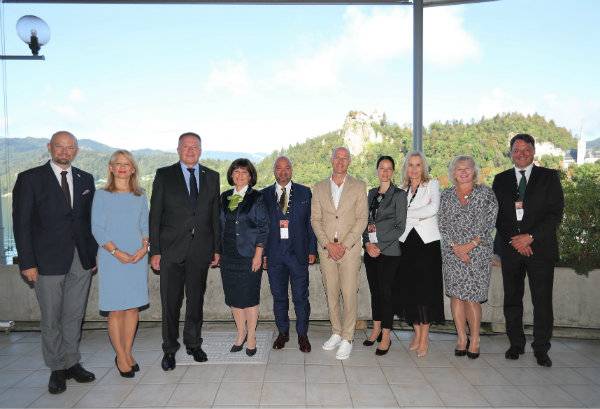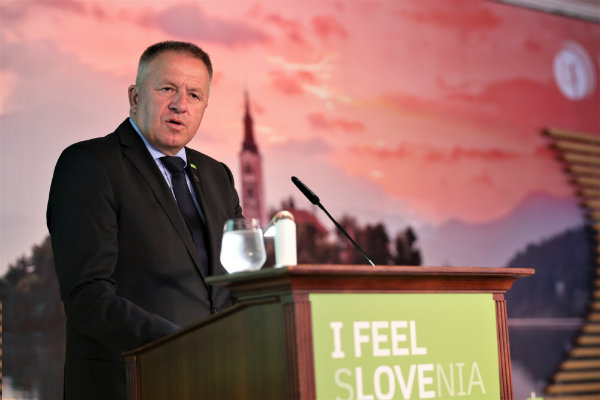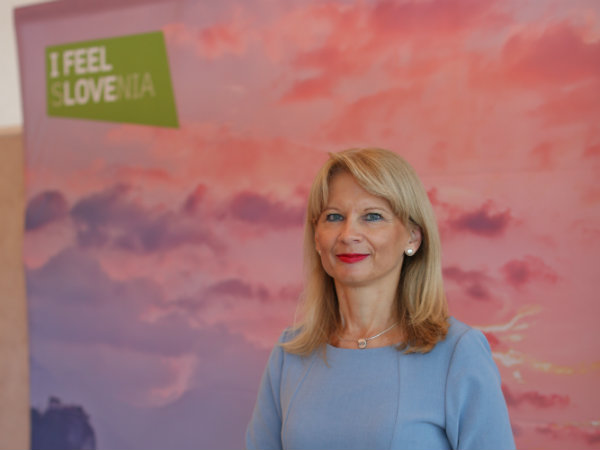- Media Centre
- Press releases
- Bled Strategic Forum addresses challenges in global tourism
Bled Strategic Forum addresses challenges in global tourism
Bled Strategic Forum addresses challenges in global tourism
The 14th Bled Strategic Forum (BSF), the leading international conference in Central and South-East Europe, included a panel on the topic of tourism, entitled “Tourism for all destinations: Dispersal over space and time”.

The headline theme revolved around identifying (re)sources of (in)stability regarding peace and security, sustainable development and economic progress, and finding ways to efficiently manage strategic resources.
The need to travel is becoming one of the fundamental needs of modern society, which in particular seeks to visit the most popular and best-rated locations in the world. Can we influence this, modify anything, or perhaps redirect guests?
Here are the key messages of the panel:

The thinking that tourism-related inflows can be increased mainly by building new accommodation capacities, since they are full in the summer months, is outmoded.
“Digitalisation has created many new services and changed our lives. Society 5.0 presents numerous challenges, including in the tourism sector. Today information spreads more rapidly, and this means travel has become cheaper and more accessible for everyone. The majority of attractive and well-known destinations have acquired even greater popularity. Meanwhile other destinations are struggling to draw the attention of potential tourists. It is important for us to have the knowledge and skills to direct tourist flows. Examples of expert knowledge, skills and best practices are of great importance for developing sustainable tourism, which will satisfy the needs of tourists, tourism stakeholders and local residents,” pointed out Zdravko Počivalšek, Minister of Economic Development and Technology and went on explaining: “The thinking that tourism-related inflows can be increased mainly by building new accommodation capacities, since they are full in the summer months, is outmoded. Destinations that have the possibility of 365-day tourism – and Slovenia is definitely one of those – must strive to fill up their capacities in all seasons, in all 12 months of the year. But to do so, it is not enough to undertake a makeover of one hotel, or one leading tourist destination. Dispersal over time and space requires that we expand our gaze to a wider and especially further view.”
In Slovenia, a selection of long-term strategies and approaches is being used, with the core of operations being sustainability.

Maja Pak, the director of the STB, gave a talk highlighting the fact that there has been a dramatic rise in the number of the destinations that in recent years have recorded increased numbers of visitors in the recent years: “Overtourism is becoming one of the hottest discussions in the modern age of travel. But this phenomenon is far from new. The thing that is new in the last few years is the challenges for local residents. Numerous destinations are trying to tackle this issue. Of course, there is no magic formula and standard solution that would work everywhere. In Slovenia, a selection of long-term strategies and approaches is being used, with the core of operations being sustainability. We know that quality is more important than quantity, thus our attention is focused on long-term values such as mutual relations and authenticity and the inclusion of the local communities in the process. I am proud that all the key stakeholders of Slovenian tourism have opted for a sustainable path, which accords with our identity, and that we aim to become a green boutique destination for five-star experiences. Of course, numerous challenges await us, but we have a clear goal and strategy of how to achieve this. It is of great importance that we all agree that Slovenia must become a place that enables a high quality of life for local residents and outstanding experiences for its visitors.” The STB director added: “Next to addressing demanding tourists who value efforts towards sustainability and promoting arrivals outside the season and visits to lesser known destinations, the STB is pursuing a number of activities to promote the development of sustainable tourism and the creation of five-star experiences: we have tools that rate sustainability efforts, such as the Green Scheme of Slovenian Tourism, we developed the Slovenian Unique Experiences brand and a new model of organising Slovenian tourism through the coordination of 35 leadings destinations. We also aim to introduce modern technologies into promotion and development and educate and train stakeholders.”
Our fundamental orientation is towards the sustainable development of tourism, which is the only right path.
Eva Štravs Podlogar, the state secretary at the Ministry of Economic Development and Technology, noted:“As in all things in life, we need to be moderate and optimal in our use of various resources in tourism. Our fundamental orientation is towards the sustainable development of tourism, which is the only right path. It is important to have an appropriate dispersal of resources and tourism visits over space and time. Tourism providers are striving to develop attractive tourism products throughout the year. Equally, by creating attractive tourist products and five-star experiences, different and hitherto lesser known destinations are striving to attract both domestic and foreign tourists. We have quite a number of high-quality, innovative and representative services on offer in Slovenia that are competitive at the global level. Here for the moment we are not facing the problems of excessive tourism, nor do we wish to encourage mass tourism. We are aware that the most important thing is a high-quality, boutique product for visitors, emphasizing an individual approach. In today’s discussion we can find verification that we are on the right path, something that international professional circles recognise in us.”
Speaking of sustainable tourism, we must think not only and exclusively from an environmental point of view.
Sergio Emidio Bini, the Provincial Councilor of Friuli-Venezia Giulia for Economic Affairs and Tourism, stated: The concentration of tourists on the most popular destinations is a theme strongly studied especially for Italian destinations such as Rome, Venice, Florence (overtourism). The management of this phenomenon can be tackled in different ways, but it is unthinkable to prevent people from visiting these places, also because the choice of such destinations arises in the early stages from travel planning. The strategies that the most advanced destinations put in place aim to differentiate the tourist offer to intercept different segments.In Friuli Venezia Giulia we have the example of the Friulian Dolomites, which are part of the UNESCO world heritage and which do not suffer from overtourism as elsewhere in the Dolomites. It is our goal to work towards sustainable development of the Friulian Dolomites, preserving the fundamental value of the wilderness that no longer exists elsewhere. Speaking of sustainable tourism, we must think not only and exclusively from an environmental point of view. From the first concept that took into consideration the impact of tourism on the environment, therefore pollution and environmental degradation linked to tourism, we now move to a more complex concept: sustainable tourism is now the tourism capable of satisfying the needs of today's tourists and host regions, foreseeing and increasing opportunities for the future. All resources must be managed in such a way that the economic, social and aesthetic needs can be met by maintaining cultural integrity, essential ecological processes, biological diversity, and the life systems of the area in question.Sustainable tourism products are those that act in harmony with the environment, the community and local cultures, so that they are the beneficiaries and not the victims of tourism development.”
Universal freedom of travel and the right of access are no longer free of charge goods that can be afforded by everyone.
“Continuous growth in travel, planetary change, environmental and socio-economic issues such as climate change, demands for more equitable use of resources, visitor satisfaction and quality of life for the locals etc. require new approaches to regulating tourism flows and tourism management. Universal freedom of travel and the right of access are no longer free of charge goods that can be afforded by everyone. Restricting and redirecting tourism flows is one of the management practices that respond to excessive growth and crowded visitors. Sustainable tourism as a concept takes into account the benefits and satisfaction of all stakeholders. It is achieved through active policy and by implementing sustainable principles responsibly in tourism practice," stressed Prof. Dr. Tanja Mihalič, Vice-Dean in Student Affairs at the Faculty of Economics, University of Ljubljana.
We believe that tourism needs to become a win-win for all who are involved.
“Every year, more and more people are traveling, many wishing to see the world's most famous tourists' sights.This is the consequence of the fact that moving around got much easier and that most destinations have focused on seeking to attract tourists. But once the tap of tourism flow is opened, it is virtually impossible to stop it. Most people who want to see Venice, Barcelona, or Paris won't be interested in seeing Verona, Zaragoza or Reims. The consequences of unsustainable tourism are severe. The example of Venice shows how residents are impoverished, displaced, and their local culture, heritage, identity, environment threatened. The experience of cultural travellers is seriously damaged, too.We believe that the most important course of actions to undertake nowadays is to change the way we approach tourism, moving from marketing to developing a new system that benefits all: the residents and visitors. We believe that tourism needs to become a win-win for all who are involved. Mass tourism means that cultural visitors have a frustrating experience and that the major part of tourism revenue leaks out of the destination and does not enter the local economy. Through our work in Venice, with Venezia Autentica, we have developed an effective model allowing that local businesses and inhabitants also have something out of it. We use digital technologies to influence visitors’ mindsets and behaviours as well as equip them with the tools they need to feel like locals. At the same time, this positively impacts the local community. This model is easily replicable and adaptable to other destinations and we are trying to work with governments around the world to help them adopt it and transform tourism in a driver of sustainable development,” said Valerie Duflot, the Managing Director and Co-founder of Venezia Autentica.
Success depends on good coordination between the private and public sectors and cooperation with the local community.
Daniela Wagner from the PATA for Europe Pacific Travel Association stressed that the key question is how we can maintain a healthy tourism growth while achieving sustainable destination development: "If we do not achieve this, the planet will be uninhabitable in a few years' time. In doing so, there are four P’s: people, planet, profit, peace. Success depends on good coordination between the private and public sectors and cooperation with the local community. It is important to use smart technology to manage the number of guests at your destination and their movement. We identified five key problems in tourism: alienated locals, degraded tourist experiences, congested infrastructure, damaging nature and endangering culture and heritage. Practical solutions include, for example, the regular collection of relevant data and their analytical processing, the development of strategies based on sustainable growth and destination management, involvement of all stakeholders, dispersal of tourists throughout the year and across destinations, different sources of funding, regulation of accommodation providers etc. It is crucial that the entire tourism economy understands that quality is more important than quantity, that they should strive to extend their tourist stay, create an offer that will include less visited destinations and special off-season."
When people talk about tourism, they forget about political and religious differences, sit at the same table and talk.
Andrew Agius Muscat, the Mediterranean Tourism Foundation from Malta, said that one-third of tourists come to the Mediterranean to see how we live: “So we are stars too. Tourism is a wonderful industry, and we must congratulate ourselves to be part of this remarkable story. When people talk about tourism, they forget about political and religious differences, sit at the same table and talk. Of course, there are problems like in any other industry - so it needs to be managed properly. It is important to have a vision, to know what we want to achieve – and then we can talk about solutions. If we want sustainable development, we must work together, as a whole region, beyond national borders. Deliver ideas, seek solutions, as this brings benefits for everyone. All providers, all stakeholders must be included in the design of tourist offers in order to truly integrate the elements of sustainability, seasonality, diversification of tourist flows. We must bear in mind that people live in the destination - not because of tourism - and that it is essential to improve the conditions that people live in and meet their needs."
Overtourism is a very complex issue that cannot be solved overnight.
Marjan Beltram, Executive Director of Tourism and Mobility Services at Nomago, pointed out that the development of sustainable tourism is a long-term process: In some cities people already feel the pressure of tourism and the reaction of city governments should be faster. It is a very complex problem that cannot be solved overnight. On one side we have huge benefits of tourism on the local and state economy but on the other side there numerous negative effects and the first step to tackle this is consistent communication. We cannot really stop anyone from doing something or visiting something, but we can inspire and redirect them. With this in mind, there are some measures countries can take, and they are two-fold: there’s the so-called “soft” approach by trying to inspire visitors with content marketing, and a “hardcore” approach, such as higher prices, tourist taxes, restrictions on the number of permitted visitors, maybe even visas for certain destinations, and overall stricter regulations. Of course, a combination of both would be optimal, and this is the task for all stakeholders.”
International tourism is growing exponentially and is outstripping the predictions
In 2018 there were 1.4 billion tourist arrivals worldwide, which exceeded the long-term forecasts of the World Tourism Organization UNWTO, which back in 2010 predicted such growth only for 2020. Current indicators point to tourist arrivals reaching 1.8 billion in 2030. Some parts of the world are becoming increasingly wealthy, with a strengthening particularly of the middle class, which according to predictions from the World Travel & Tourism Council should grow by a billion by 2030. Travel is becoming increasingly attainable thanks in part to the low prices of budget operators, while a part is also being played by phenomena such as Airbnb. The world is racked in places by natural disasters, economic crises, epidemics and terrorism, which represent the main causes of instability in tourism, but on the other hand this does not stop travellers seeking to discover new destinations.
Tourism has the power to be a tool for establishing peace and balance between different, more and less developed parts of the world, but at the same time, as some destinations report, it can negatively impact the natural world, contribute to pollution, choke up transport routes, lower the quality of life for local residents, impact local culture and customs and destroy the local aesthetic.
Nevertheless countries, destinations and companies are “fighting” a sophisticated battle on the global tourism market for guests, since tourism positively impacts the global economy: in worldwide terms it generates 10% of GDP, one out of every ten jobs and 30% of service exports. A great help in this battle is new technologies, which have brought changed and highly effective concepts for promotion that can reach millions of potential guests. Combining the real and virtual world can be an added value in services offered, and can attract the younger generations, while making it easier for older guests to experience certain destinations or products. But the new technologies of hyperconnectivity in the age of Society 5.0 have another side which is difficult for providers to influence: they take away a great deal of the power to steer people. Guests give ratings and exchange advice about where, when and why to travel – or not – and the information flows between them instantaneously and unstoppably. Tourism flows are formed in an organic way, Instagrammable locations become even more popular, while others, despite the efforts of destinations and providers, have a difficult job of breaking through to the available guests. Questions arise here as to whether we have sufficient knowledge, tools and resources to guide and stabilise tourism flows, whether we can develop sustainable tourism that will satisfy local residents, guests and all stakeholders, and how much can modern technologies help us in this.
Cover photo (from left): Christian Kresse, Msc. Maja Pak, Zdravko Počivalšek, Eva Štravs Podlogar, Andrew Agius Muscat, Marjan Beltram, Valeria Duflot, prof. dr. Tanja Mihalič, Daniela Wagner and Jaka Repanšek.
Photo credit: Nino Verdnik
Contacts
Global public relations and Marketing
e-mail address: press(at)slovenia.info
